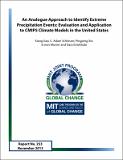| dc.contributor.author | Gao, Xiang | |
| dc.contributor.author | Schlosser, C. Adam | |
| dc.contributor.author | Xie, Pingping | |
| dc.contributor.author | Monier, Erwan | |
| dc.contributor.author | Entekhabi, Dara | |
| dc.date.accessioned | 2013-11-05T14:47:34Z | |
| dc.date.available | 2013-11-05T14:47:34Z | |
| dc.date.issued | 2013-11 | |
| dc.identifier.uri | http://hdl.handle.net/1721.1/81992 | |
| dc.description.abstract | Global warming is expected to alter the frequency, intensity, and risk of extreme precipitation events. However, global climate models in general do not correctly reproduce the frequency and intensity distribution of precipitation, especially at the regional scale. We present an analogue method to detect the occurrence of extreme precipitation events without relying on modeled precipitation. Our approach is based on the use of composites to identify the distinct large-scale atmospheric conditions associated with widespread outbreaks of extreme precipitation events across local scales. The development of composite maps, exemplified in the South-Central United States and the Western United States, is achieved through the joint analysis of 27-yr (1979–2005) CPC gridded station data and NASA's Modern Era Retrospective-analysis for Research and Applications (MERRA). Various circulation features and moisture plumes associated with extreme precipitation events are examined. This analogue method is evaluated against the MERRA reanalysis with a success rate of around 80% in detecting extreme events within one or two days. When applied to the climate model simulations of the 20th century from Coupled Model Intercomparison Project Phase 5 (CMIP5), we find the analogues from the CMIP5 models produces more consistent (and less uncertain) total number of extreme events compared against observations as opposed to using their corresponding simulated precipitation over the three regions examined. The analogues also perform better to characterize the interannual range of extreme days with the smaller RMSE across all the models for all the descriptive statistics (minimum, lower and higher quartile, median, and maximum). These results suggest the capability of CMIP5 models to simulate the realistic large-scale atmospheric conditions associated with widespread local-scale extreme events, with a credible frequency. Collectively speaking, the presented analyses clearly highlight the comparative and enhanced nature of these results to studies that consider only modeled precipitation output to assess extreme-event frequency. | en_US |
| dc.description.sponsorship | This work was funded by the NASA Energy and Water Cycle Study Research Announcement
(NNH07ZDA001N) and MacroSystems Biology Program Grant (NSF-AES EF#1137306) from
the National Science Foundation. We acknowledge the modeling groups, the Program for Climate
Model Diagnosis and Intercomparison (PCMDI), and the WCRP’s Working Group on Coupled
31Modeling (WGCM) for their roles in making available the WCRP CMIP5 multimodel data set.
We thank the NOAA Climate Prediction Center for the global gridded precipitation observations
and the NASA Global Modeling and Assimilation Office for the MERRA Reanalysis data. | en_US |
| dc.language.iso | en_US | en_US |
| dc.publisher | MIT Joint Program | en_US |
| dc.relation.ispartofseries | MIT Joint Program Report Series;Report 253 | |
| dc.title | An Analogue Approach to Identify Extreme Precipitation Events: Evaluation and Application to CMIP5 Climate Models in the United States | en_US |
| dc.type | Technical Report | en_US |
| dc.identifier.citation | Report 253 | en_US |
